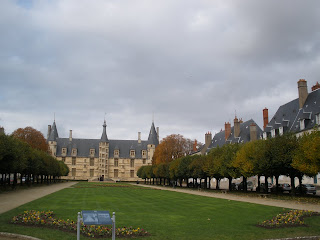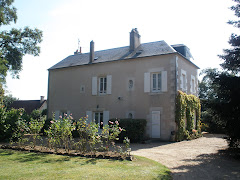When I lived in Toulouse, I had the amazing good fortune to take classes at the
Conservatoire National de la Région de Toulouse (The National Conservatory of the Region of Toulouse). There, I took oboe lessons with two professors, one of whom had studied at the Paris Conservatory in the 1960s and had thus participated in or at least witnessed the french national school from
très proche (up close). This professor, Monsieur Fussis, thus told me all about his experiences with Francis Poulenc as he was working on his
Sonate pour hautbois et piano. The
Conservatoire in Toulouse was lively, but certainly full of young musicians, mostly in middle and high school, who were considering the pursuit of careers as professional instrumentalists. They were at the age where, if they practiced enough, the musical talent that their teachers had identified when they were very young, could bear fruit in the professional realm. I thus played in a youth orchestra and waited for my lessons with a young high schooler- maybe he was in
seconde (sophomore year)? I took my
solfège (applied music theory) class with adults, but this was a bit rare, and as I never ran into my classmates at the
Conservatoire, I got the distinct impression that there, musical practice revolved around the youth.
Music, Monsieur Fussis once explained to me, is considered by the french a
métier (professional activity) much more than an
art, so musical education in France is highly regulated. Musical instruction or activity of any kind is rare in a normal school and is for the most part relegated to the regional conservatories. These centers are operated by the state and their curriculum comes from the center of the nation, Paris, where directors decide on the exam pieces, repertory, and instructional methods. Each
Conservatoire has its prizes, but the only ones that matter come from Paris. Thus, as students progress, they try their hardest to earn a spot at this renowned musical epicenter, sure that if they have their diploma from this school, they will find work. This means that although Paris is clearly in a distinctly priviledged position, it is not removed in an isolated elitist way. Paris is connected with the whole
réseau (network) of
Conservatoires, or more aptly, this
réseau revolves around the capital. Students thus have the hope of moving to Paris one day if they have both the talent and the discipline to progress to a high level. The standards are high, but they are clear and fair-- in line with the French ideal of
égalité (equality).
In Nevers, unlike in Toulouse, the musical activity radiates from an
École Nationale de Musique (National School of Music). As far as I have been able to understand, this has the same legal and musical standards as a
Conservatoire National except that an
Êcole is found in the
préfecture du département in contrast to a
Conservatoire, which is located in the
chef-lieu de la région. It's a bit complicated, sure, but the French love their hierarchies as a result of their extreme centralization. In any case, the
Région where Nevers is located,
la Bourgogne has its
chef-lieu in Dijon. The
Département, which is part of the
région, is called
la Nièvre, and Nevers is the
préfecture. Think of Nevers as Gainesville, which is the county seat of Alachua County and Tallahassee as the capital of Florida. The administration works kind of like that. Since Nevers has no
Conservatoire, the
École Nationale de Musique is the best musical institution in the city and in the wide surrounding area. Here one finds all of the musical activity possible, including individual instruction, group practice,
solfège studies: the works. And, since there is no official
Conservatoire, when people refer to the school of music, everyone uses the word
"conservatoire," to add imprecision to the otherwise orderly system.
As seems to be the case here in Nevers, the
conservatoire's network touches many parts of the society. When I told Françoise that I sing and would like to continue studying voice if possible, she told me I needed to go see the director of the
conservatoire, whom she knows personally because her children studied music for many years. I went to the
conservatoire on my second day in Nevers, introduced myself to the
directrice, mentioned Françoise's name, and left my number so I could be contacted when the
chorale (large chorus) started its repertory for the fall/winter season. I later learned that a few of the teachers at my
lycée sing at the
conservatoire, including one of the English teachers, Catherine Lebrun, who volunteered to drive me to the rehearsals, since they begin at 8:30pm on Thursday nights. The rehearsals for the
chorale began earlier than expected, and before I knew it, I was being whisked off into the Thursday evening darkness week after week to sing
avec les potes (with friends, as they say in the Burgundy region). In all, there are two
lycée teachers in the
chorale, but I haven't noticed any of my students there. The people there are certainly friendly, and there is always lots of lively discussion as the members arrive for each rehearsal.
One contrast between this
École and the
Conservatoire in Toulouse: the average age of the people I see there. The
chorale is above all an adult group. There are maybe four or five twentysomethings in the group other than myself, and the next age group begins at the
cinquantaine (the fifty-year mark).
Cela ne me dérange pas (that doesn't bother me), but it certainly is a change of pace to be surrounded by baby boomers and not their children. As I was discussing with Sarah, a french student of musicology and musical pedogogy who sings in the
chorale, the frustrating part about the age group is that the adults, paradoxically enough, don't seem to learn their music very quickly. Compared to children, they have lost the habit of adapting to and assimilating new information all the time. The
chef de choeur (choir director) usually makes us repeat a stylistic adjustment about five times before everyone in the group has made the change, and even then...
enfin (oh well). The group of adults is quite mixed in terms of musical knowledge and voice training, and while a majority has a strong hold of musical expression and the use of the voice, certain hae pronounced difficulty in the sensitivity of the musical phrase. It is great for the community that the
Conservatoire offers such a group practice, but I am still mystified that there aren't more young people in the group.
Sarah and I were chatting the other day about musical practice in France, and although the system seems much more strightforward to navigate than the American system, the musical profession is still extremely difficult to penetrate. Contemporary society seems not to have a need for many professional instrumentalists,
alors (so) the spaces in musical schools are limited. Sarah realized after years of piano and cello lessons that she would never be a professional, so she attempted a medical degree. After one year of medical school, she had had enough and knew that she had to follow her musical passion. She went to the director of the
conservatoire in Nevers to ask what course of study she could follow, and she decided upon teaching:
solfège, piano, and directing choirs. She has many years of studies ahead of her, but I think the Conservatory system will help her arrive at her goal. In any case, I'm glad she's there, because she seems to be someone who is in a similar position to mine, and she is helping me understand a lot about the group dynamics in the
chorale and in the
classe de chant (voice class with both individual and group instruction), which makes the whole experience much richer for me.
Le Conservatoire n'est pas que les vieux ! (The Conservatory isn't only for the old people!)
I'll be sure to write more about the
cours de chant soon, especially once I understand a bit more about how my voice teacher, a Bulgarian, found her way to Nevers, and what her students have gone on to accomplish. There's a week of activities around a Bulgarian composer, Isabelle Alboulker, that involves many parts of the Conservatory, and that should create some activity in the city as well. But for now, I think it would be good to go sing in a practice room!
A bientôt,
Megan










